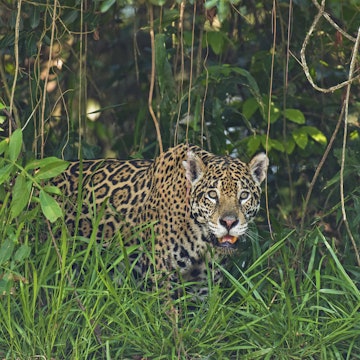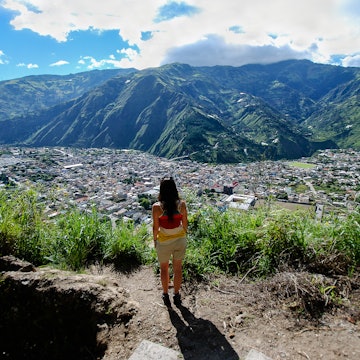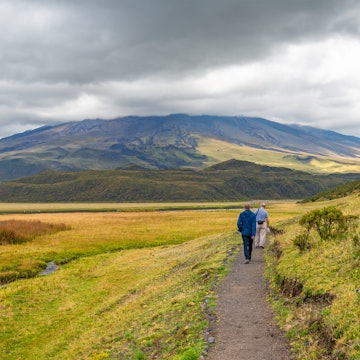
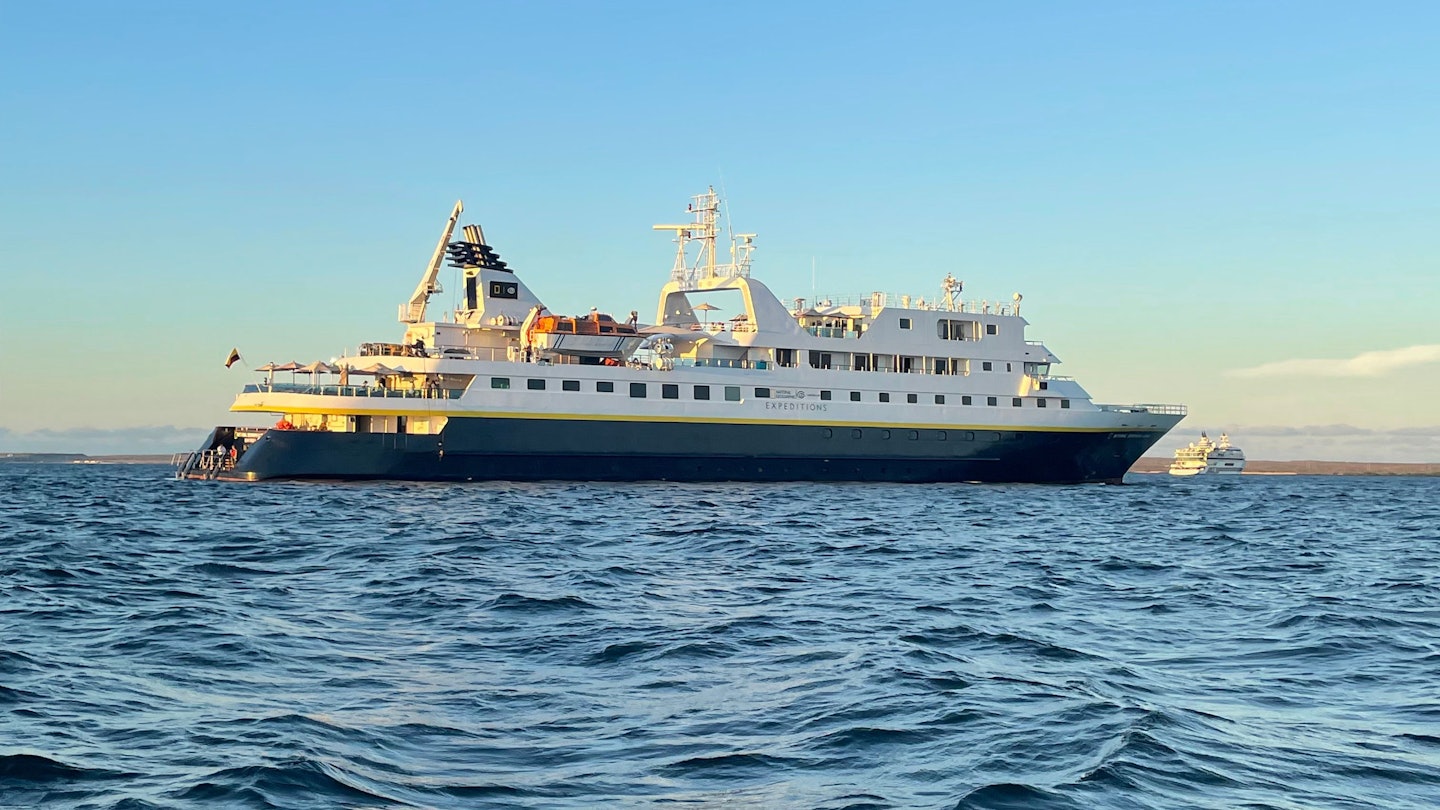
The National Geographic Gemini. Sandie Kestell/Lonely Planet
The Galápagos Islands rank high on many travel bucket lists, and they were near the top of mine. However, they had always felt like a once-in-a-lifetime destination that was just out of reach, and I had no idea when I might get the chance to visit. When an invite came in from National Geographic-Lindblad Expeditions, I couldn’t believe my luck. What could be better than joining an expedition with the pioneer of modern expedition cruising? My expectations were high, and my imagination was running wild.
What followed was a jam-packed week of adventure on one of the inaugural voyages of the 48-passenger National Geographic Gemini, one of the newest additions to the National Geographic-Lindblad Expeditions fleet.
Turtles or penguins? Kayaking or hiking? Bird-watching or paddleboarding? These were the hardest decisions I had to make all week, but there were no wrong answers, just more wildlife encounters, stunning landscapes and underwater worlds. Did it live up to expectations? You bet. And I’m already dreaming about going on another expedition with National Geographic-Lindblad.
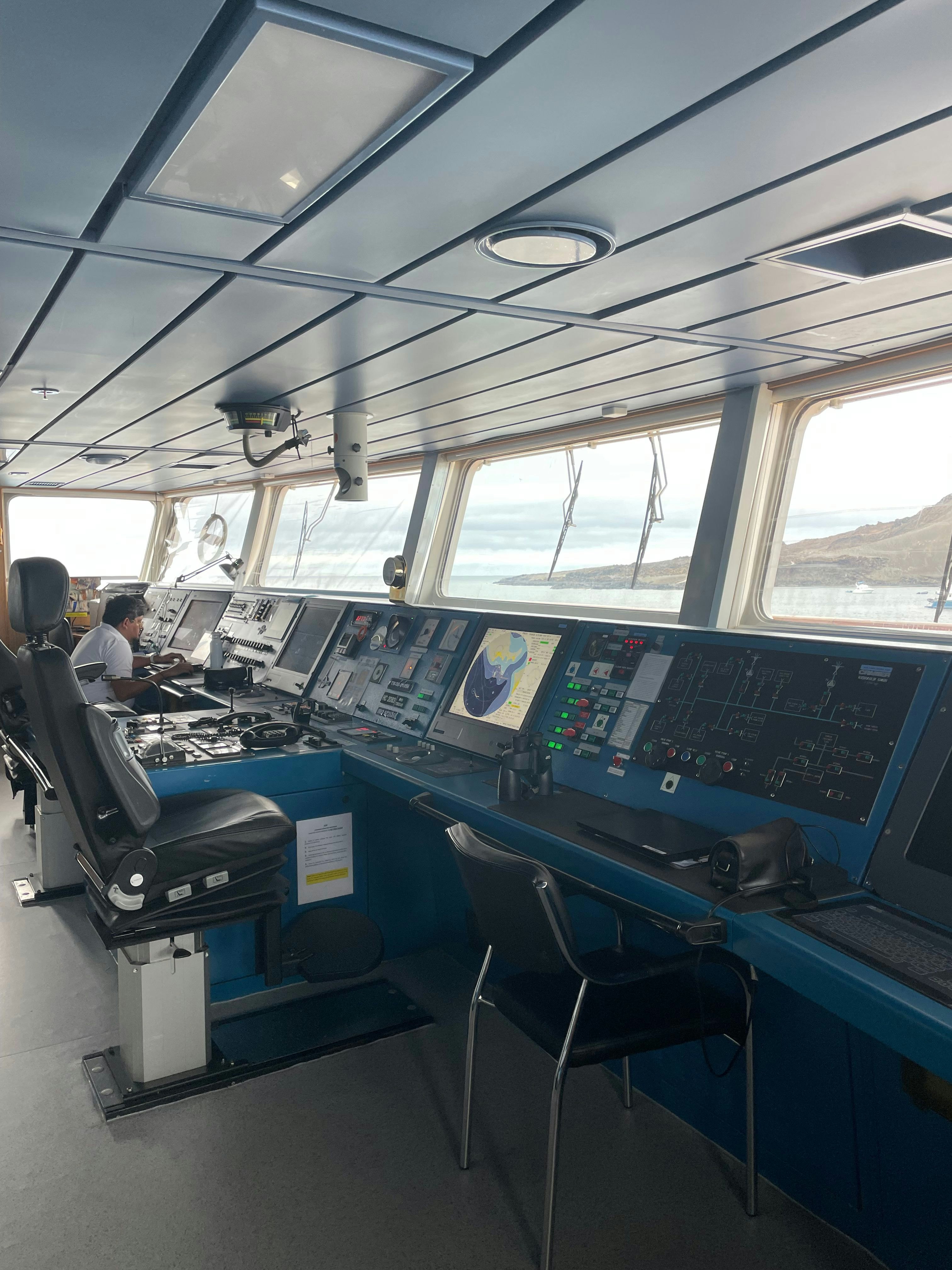
Part 1: Pre-expedition and heading to the Galápagos
Before the expedition, National Geographic-Lindblad Expeditions shared a lot of material, including a packing list, a reading list and photography guidelines, so there was plenty to get my teeth into before I left. When the time comes, passengers fly into either Quito or Guayaquil and spend the night before flying to Baltra, Galápagos Islands, the following day. I arrived at Guayaquil after a long flight from Dublin via Madrid, and the National Geographic-Lindblad transfer team met me in the arrivals hall for the transfer to Hotel Oro Verde Guayaquil. We used the journey to chat about the plan for our departure to Galápagos the next day and final formalities like completing the online Galápagos Biosecurity Declaration.
After an early wake-up call and preparing luggage for pickup, I collected my boarding passes from the hospitality team in the lobby and met some of the other passengers. After breakfast we set off with our guide to José Joaquín de Olmedo International Airport in Guayaquil for the two-hour flight to Baltra Island.
Members of the crew met us at the airport, and we took a five-minute bus ride to the port. There, we caught our first glimpse of the ship, the National Geographic Gemini, anchored out in the bay. Zodiac schooners cruised in to pick us up and ferry us aboard. Once on board, we met more of the crew, who are all Ecuadorian.
We settled into a buffet lunch before gathering for an orientation briefing, where we started to get a picture of the Gemini’s decks and facilities and the logistics of the expedition from daily briefings right through to excursions, landings and recaps. Expedition leader Jonathan Aguas talked us through the rules of visiting Galápagos National Park and how to respect the environment.
Part 2: Expeditioning
Our itinerary took us from the central islands of Santa Cruz, Rabida and Santiago out to the western islands of Isabela and Fernandina – the youngest in the archipelago – and then back eastward to Santa Cruz again, north to Genovesa and finally back to Santa Cruz and Bartolomé.
Days on board start early, with an early riser’s fare available from 6am to set you up for any prebreakfast excursions. All of the activities are optional, but like many of the passengers, I had already decided to see and do as much as humanly possible, and I stuck to that plan for the week. Each night at our briefing, expedition leader Jonathan explained the activities and shore excursions available for the next day and advised us on the appropriate footwear to wear for the landing and activities. There were four naturalists on board, and for each excursion, we would break into groups accompanied by one each.
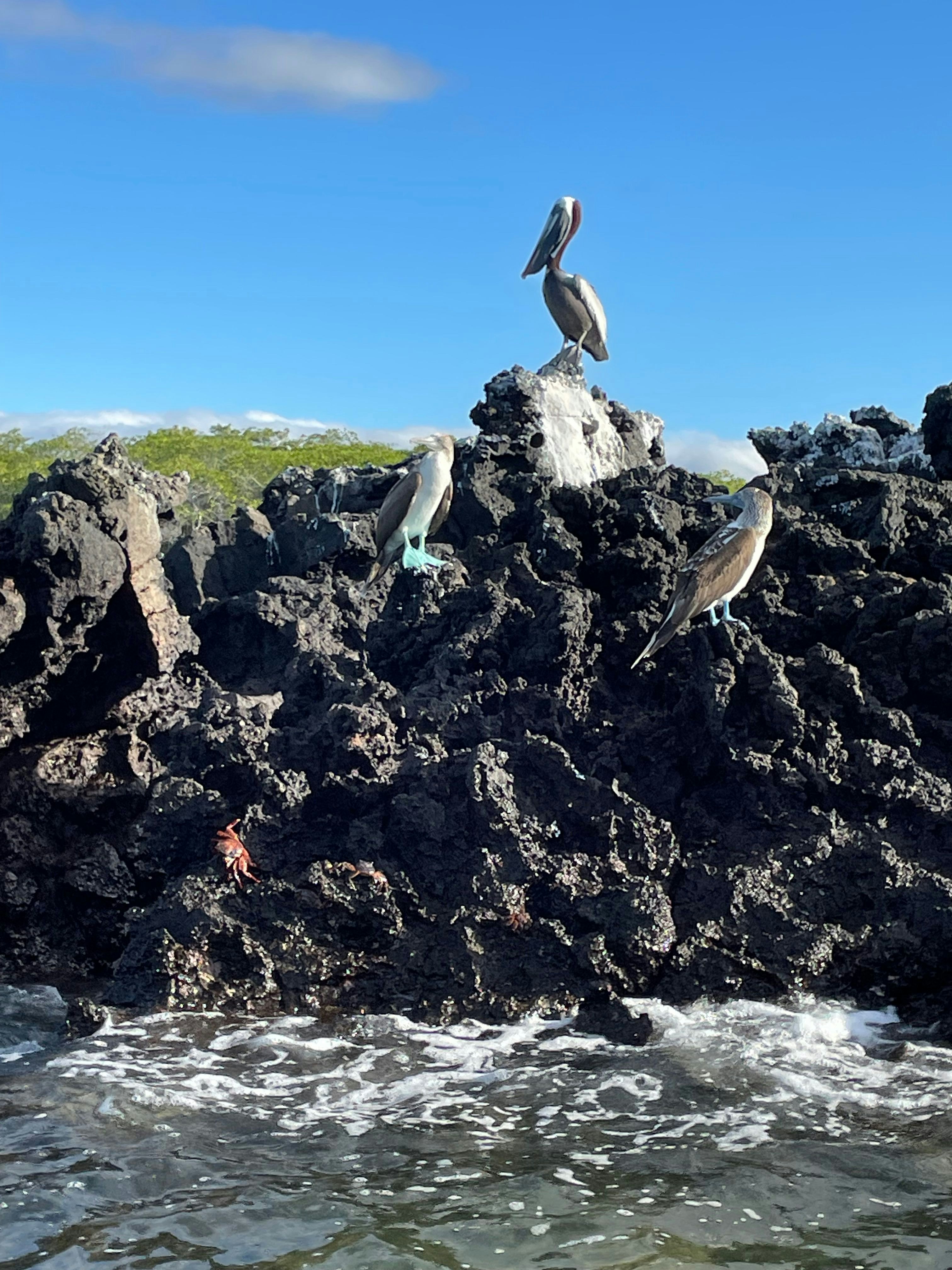
Early days in the central islands
We headed out for our first excursion on the first evening. There was a buzz of excitement as we slipped on lifejackets and boarded the Zodiacs, each with a sailor and naturalist, for a late afternoon ride into Black Turtle Cove on Santa Cruz. We glided into a tranquil mangrove lagoon and spotted our first blue-footed boobies on a rocky outcrop, and then a spotted eagle ray and several green sea turtles under the surface.
On our second day, we visited one of the smaller islands in the Galápagos: Rabida. We took an early-morning walk on the only red-sand beach in the Galápagos and found a flamboyance of flamingoes feeding in a saltwater lagoon behind the beach. Back on the beach itself, we met half a dozen sea lions lazing in the sun and spotted some others playing in the shallow water.
After the walk we got kitted out with snorkel gear and headed back to the beach for snorkel practice and an equipment check, with instructions for beginners. Back on board, the ship set sail for nearby Santiago Island, where we disembarked at Puerto Egas for a nature hike. This is one of the four islands Darwin visited, and we followed in his footsteps as we searched for wildlife. We spotted more than half a dozen different bird species, including more blue-footed boobies and our first Darwin finches; there are also great blue herons, Galápagos fly catchers and Galápagos mockingbirds, among others. We saw a few lone land iguanas almost camouflaged in the vegetation before we came across several groups of marine iguanas in the lava formations close to the shore. Here we were also lucky to spot three Galápagos fur seals resting in shaded crevices in the lava formations and a few others darting through the pools carved into the lava flow.
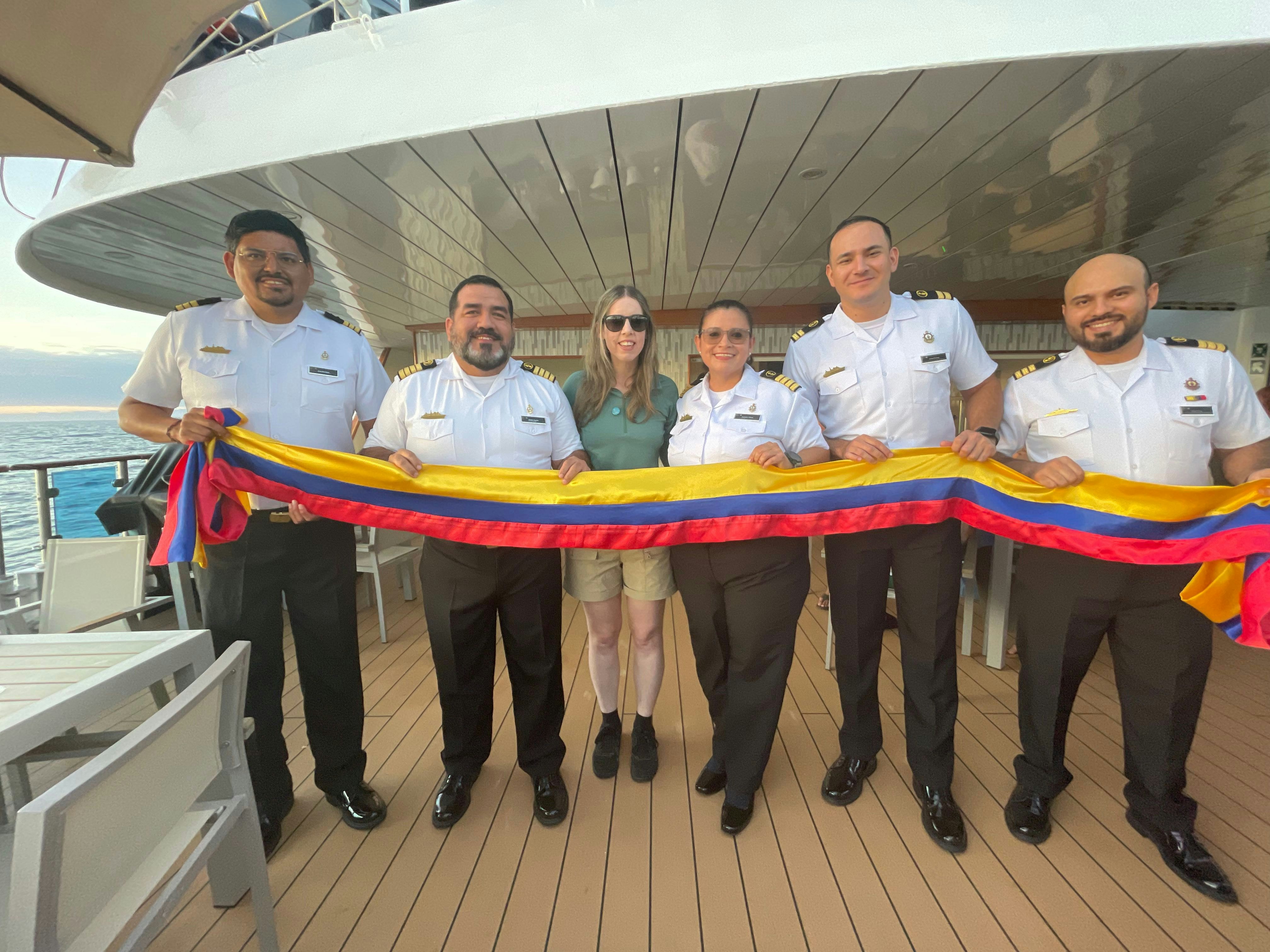
Heading west
We sailed overnight and crossed the equator twice to reach the youngest and westernmost islands in the archipelago: Isabela and Fernandina. I joined the early birds for a Zodiac ride around Tagus Cove in search of Galápagos penguins. These little penguins measure only around 30cm (11.8 inches) in height, and it wasn’t long before we spotted our first pair, perched in the coastal lava, but they dove into the water before we had a chance to get a good look. We saw just one other penguin here – a juvenile, our naturalist says, judging by its plumage – but we spotted plenty of other seabirds and shorebirds, including flightless cormorants, lava herons, brown pelicans and brown noddies.
Later that day we did our first deepwater snorkel, joined by one lone penguin torpedoing past us enough times for us to really admire him. Here we also saw green sea turtles floating along at a much slower pace. As each one was spotted, someone in the group would inevitably surface and cry, “Turtle!” with great excitement. It never got old.
We moved on to nearby Fernandina Island that afternoon, and I joined the day’s second deepwater snorkel. There are more green sea turtles here, and we were joined by a Galápagos sea lion playfully swimming with us. Here we also spotted a marine iguana foraging in the shallower water. There is nothing like seeing one of these miniature Godzillas swimming elegantly. This is as Galápagos as it gets.

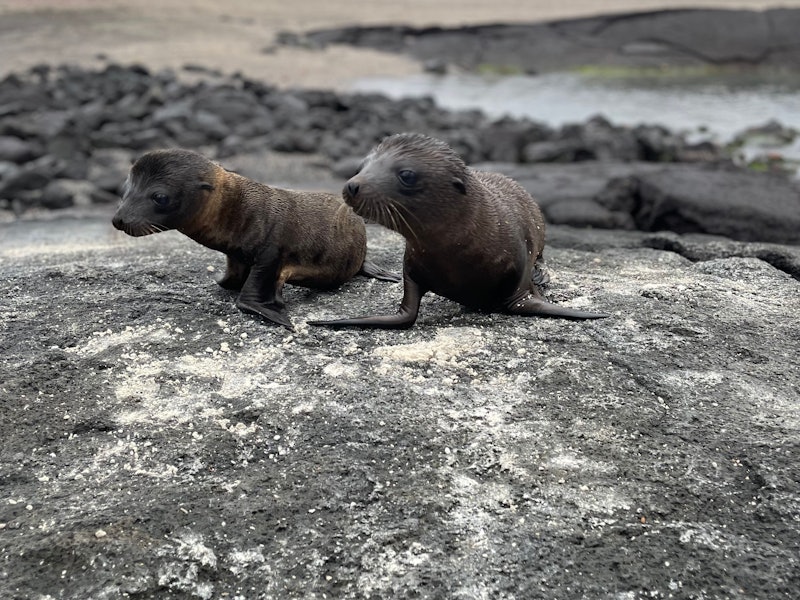
Punta Espinosa
Next we landed at Punta Espinosa for a nature hike and found dozens of large clusters of marine iguanas, cuddled together and basking in the late afternoon sun, sneezing occasionally to remove salt from their systems. As we moved past one enormous cluster, we spotted two sea lion pups playing on the lava headland at the shore. We moved in a little closer and spent close to half an hour watching these two play. A large bull sea lion (the pups’ papa, perhaps?) was patrolling this beach area and we got a reasonable look at him, too. The pups truly charmed us, and it was tough to leave them.
We sailed south overnight through the Bolivar Channel, and our first stop on day four was at Urbina Bay on Isabela Island for a nature walk. Here we saw our first giant tortoises, mostly lone adult females, but there was one group of three together. These are extraordinary creatures, and not just in terms of their size and grace. They can survive for more than a year without food or water, and this is what made them so attractive to pirates and sailors before refrigeration. So many were collected for food that several species became extinct. These ones didn’t seem to notice us at all as we marveled at their size and the patterns on their shells. We passed a few burrows on the trail before spotting a land iguana basking in the sun. Back at the beach area, we had a chance to relax and swim before returning to the ship.
I spent some time on deck that afternoon as we sailed north to Punta Vicente Roca. Someone spotted the blow of a whale surfacing to breathe in the distance. As we got closer, anyone with a decent camera was snapping pictures to try to identify the whale. Soon after we passed it, Jonathan’s voice came over the PA system to say the naturalists had identified the whale by its small dorsal fin: it was a blue whale. We were giddy as the captain turned the ship around to see if we could follow it and get another look. And we found this time getting a much clearer view of the largest animal on the planet.
We arrived at Punta Vicente Roca at Isabela on a high and headed out for a deepwater snorkel excursion. Here we saw more green sea turtles and playful sea lions, as well as all kinds of fish. Afterward it was a quick turnaround for our next excursion: a Zodiac ride along the same area, the coast of Ecuador Volcano, where we watched sea lions, brown pelicans, blue-footed boobies, marine iguanas, flightless cormorants and green sea turtles.
Back on the ship, we sailed north again and crossed the equator at sunset. Our previous crossing had been during the night, so this was our chance to celebrate crossing the line. We gathered on deck with the crew and limboed under a large ribbon in Ecuador's colors and danced the macarena. Our spirits were high as the Gemini sailed on past the head of sea-horse shaped Isabela.

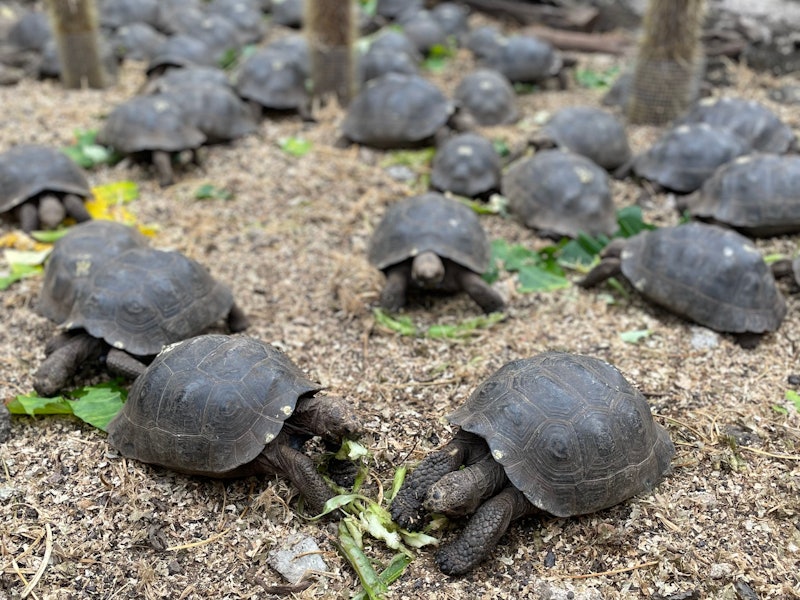
Back east to Santa Cruz
Santa Cruz is one of the four inhabited islands, and we headed onshore at Puerto Ayora to visit the Charles Darwin Research Station, founded at the same time as the Galápagos National Park (1959). We spent the morning learning about the research projects underway, some supported by Lindblad, and wider efforts to conserve and protect the islands’ heritage. The most exciting part is visiting the giant tortoise breeding center. The center is currently home to 1600 tortoises – the youngest giants we saw were just one year old, irresistibly waddling around their enclosure. They’re released back into the wild by age six. Between the staff at the center and our own naturalists, we learn all about how the tortoises are monitored and their shells marked with colored paint to signify the island they’re from. Once they’re old enough, they’re returned to the original area of their nest and chipped to monitor and track them. So far, around 7000 have been repatriated to the wild.
Next we traveled by bus to El Manzanillo Ranch in the highlands of Santa Cruz for lunch and a chance to see giant tortoises in the wild. We spotted several from the bus and saw about a dozen more feeding on the vegetation or cooling off in the pond at the ranch. We were close enough to hear them taking a deep breath before lumbering along their way. In a week filled with highlights, this was one of the best.
Back on board that evening, we were treated to a unique celebration. There were four National Geographic-Lindblad ships docked in Puerto Ayora to take part in the naming ceremony of the National Geographic Gemini and her sister ship, the 16-passenger National Geographic Delfina. With the use of a bottle made of ice instead of glass, the ship officially became National Geographic Gemini, and we joined together to wish it fair winds and fair seas. The celebrations continued after dinner, as a local band and dance troop joined us on board to play out the night.
On the way to Genovesa
The ship repositioned overnight to northern Genovesa Island, also known as the island of the birds. We disembarked early for a nature walk at Prince Phillip’s Steps to birdwatch. The island is home to some 250,000 red-footed boobies, and we saw plenty. They are the only boobies that nest in trees; they wrap their feet around to grip the branches, and this is where we saw them. We also saw Nazca boobies, Galápagos doves, frigate birds, Galápagos mockingbirds, storm petrels, and red-billed tropic birds, and we caught the briefest glimpse of an owl.
Next we deepwater snorkeled along the cliffs of Darwin Bay. As we put our masks on, our naturalist, Charly, spotted a manta ray, so we hurried into the water – some without our flippers even on yet – to get a look. The water was a little murky, but we watched as the manta glided along and then disappeared. Its wingspan was enormous, and we soon came across it again as we scoped out the area.
After lunch I opted for a kayak excursion around Darwin Bay, then a nature walk on the beach for more casual birding. We followed the beach trail and saw prickly pear cactus, yellow-crowned night herons, red-footed boobies and a few male frigate birds with pouches inflated to attract females.
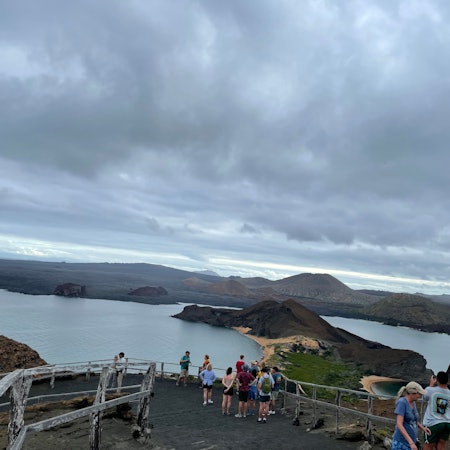
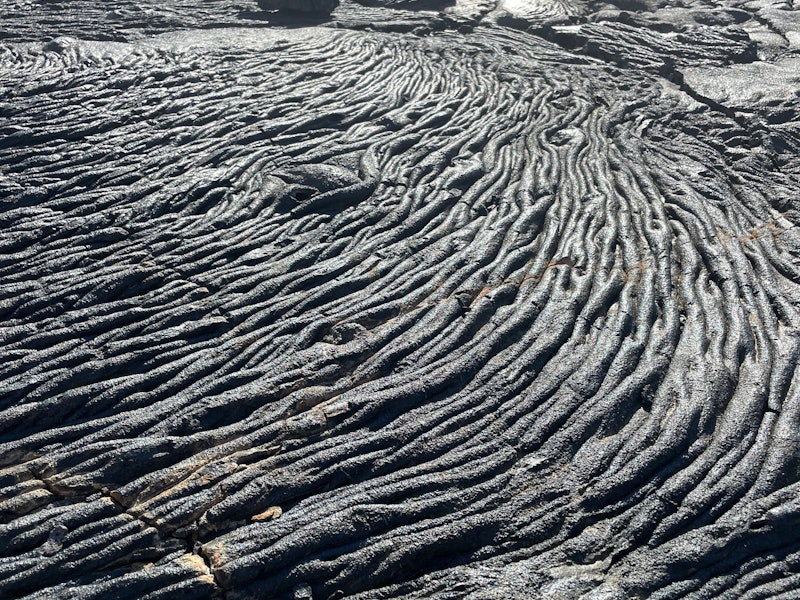
Final ports of call
The ship sailed overnight back to Santiago Island for our last full day. We set out for an early hike on the lava terrain, following in Darwin’s footsteps. I joined the fast-paced group, and we stopped regularly to look at the textures and patterns in this ocean of lava and the pioneer plants growing in the flow.
I visited the ship’s bridge before lunch, taking advantage of National Geographic-Lindblad’s open bridge policy. The third mate gave me a tour and talked me through the navigation, communication and emergency equipment. I also took up his invitation to sit in the captain’s chair – it might be my only chance!
The ship repositioned to Bartolomé Island over lunch, and we prepared for our last deepwater snorkel. The highlight here was seeing white-tip reef sharks. They’re not considered a dangerous species, but my adrenaline was pumping nonetheless as we watched them from above. Next we hiked up the 376 steps to the high point on the island. It’s a Mars-like landscape. We had a perfect view of the dramatic Pinnacle Rock and Santiago Island beyond it – an iconic Galápagos scene to finish out the week.
Part 3: A planning primer
What to pack
National Geographic-Lindblad shared a comprehensive packing list well ahead of the voyage, and I followed it pretty closely. One thing I hadn’t considered was air-conditioning. The Gemini is fully air-conditioned to keep the climate on board comfortable, but if you run cold, like me, you’ll want the extra layers. I had packed two light fleeces but ended up buying a third onboard. No regrets though – this is my favorite souvenir from the trip.
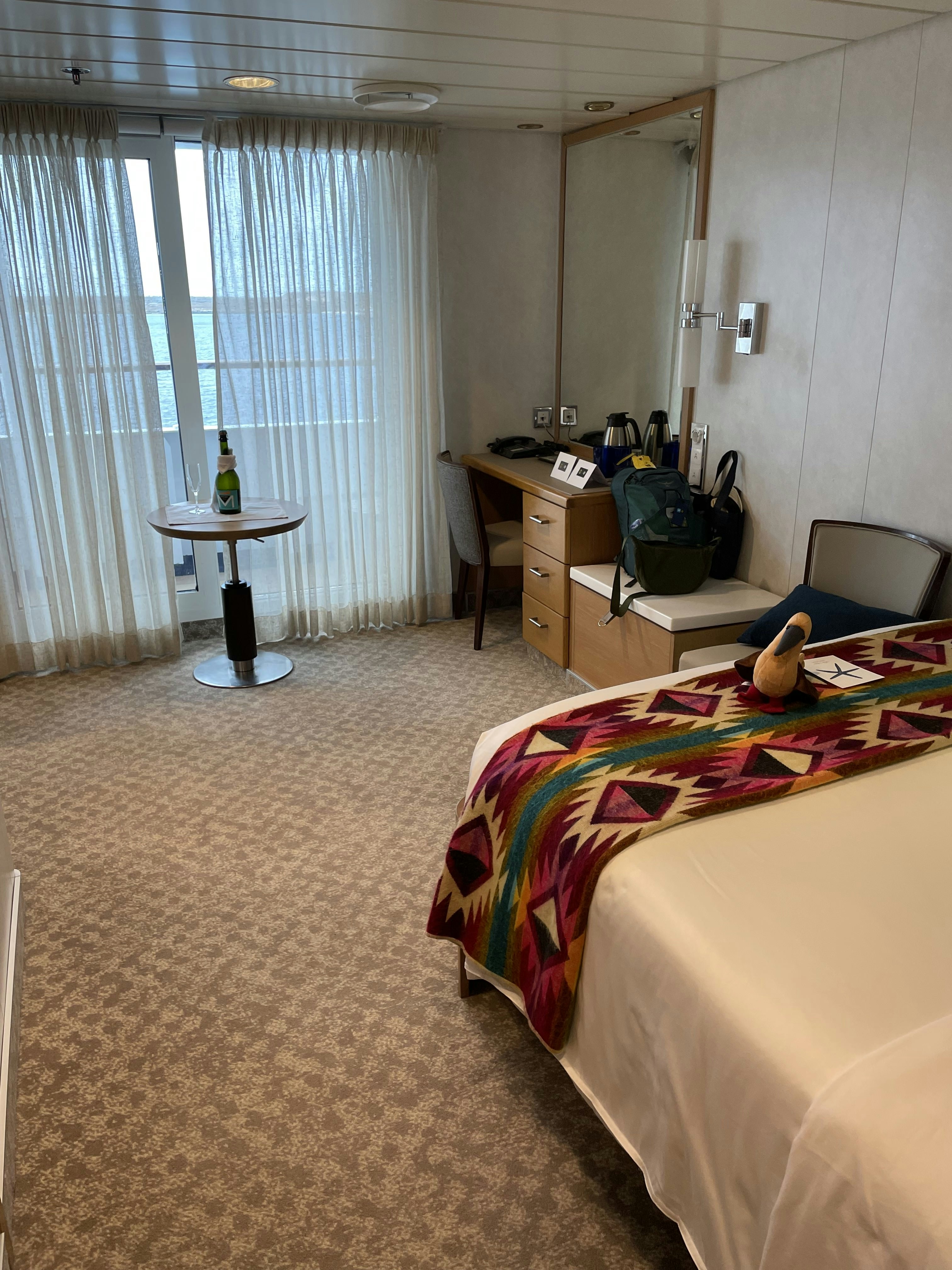
What was your cabin like?
My cabin on deck 5 was roomy, with a queen-size bed, TV, desk and small coffee table, small bathroom and a balcony. National Geographic-Lindblad has an open-door policy, meaning cabins are keyless. Having never done an expedition or cruise before, this was a surprise to me but not alarming. You can still lock your cabin from the inside, and all rooms contain a safe for your valuables, but you don’t have to worry about where to put your key card on shore excursions or activities on the water. It also made the ship feel more like home.
What was the food like?
In a word: fantastic. National Geographic-Lindblad places huge emphasis on regionally specific dishes, and all of the food served onboard was locally sourced and sustainable. From the early risers’ fare to breakfast and lunch buffets right through to a three-course evening meal, the quality was superb, and if Ecuadorian cuisine is not on your radar already, it will be after this expedition.
Sandie traveled to the Galápagos Islands on the invitation of National Geographic-Lindblad Expeditions. Lonely Planet does not accept freebies in exchange for positive coverage.












